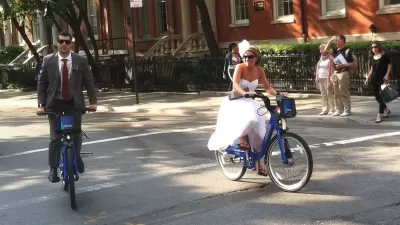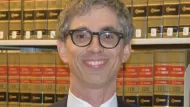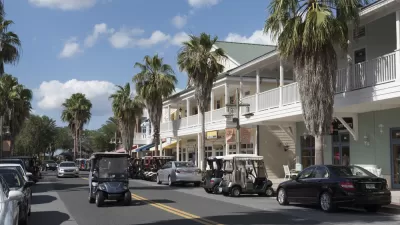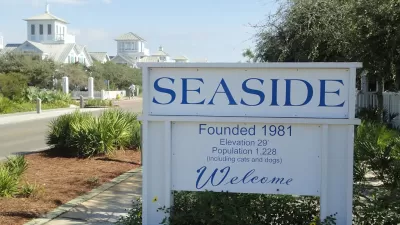A recent Newsweek article on urbanism is chock-full of nonsense.

A few weeks ago, Newsweek ran an article that parroted Joel Kotkin’s attacks on cities and those who live in them. The article's slant can be summarized in its title: "White City: The New Urban Blight is Rich People." To the extent that it involves logical argument, the article makes two claims:
1. "Rich People Are Taking Over The Cities." The Newsweek article states that something the author calls “new urbanism” (which he never really defines)* “turns cities into playgrounds for moneyed, childless whites while pushing out the poor, the working-class, immigrants, seniors and anyone else not plugged into “the knowledge economy.”
This claim does have some basis in fact: it is true that the population of well-off whites is growing in a lot of cities. But this is merely a mild correction of a trend in the other direction. For decade after decade, cities became poorer and browner, as suburbs grew richer and richer. So by the end of the 20th century, some cities were essentially holding pens for the poor. To the extent that this trend has reversed in the 2000s, such change has been merely a small step towards reversing the city/suburb imbalance. For example, the Newsweek article, by describing Manhattan as a "hive for stateless billionaires," implies that Manhattan is a "playground for moneyed, childless whites." But in fact, Manhattan is only 45 percent non-Hispanic white; by contrast, suburban Nassau County is almost two-thirds white. Twenty-one percent of Manhattan residents did not complete high school, as opposed to 13 percent of Nassau County residents. Twenty-seven percent of Manhattan's residents were foreign-born, as opposed to 19 percent of Nassau County residents. The urban outer boroughs of New York are even poorer and more diverse than Manhattan. For example, Brooklyn is 34 percent white, and 31 percent of its residents did not complete high school. Even San Francisco, perhaps America’s wealthiest urban core, is over 1/3 foreign born, while suburban Marin County is only 18 percent foreign-born. Although only 13 percent of San Francisco residents did not finish high school, that percentage is still higher than the percentage in Marin (9 percent).
So even if the "poverty gap" between city and suburb is narrowing, it will be some decades before even the most prosperous cities return to the pre-1950 status quo of being as rich as their suburbs, let alone being "playgrounds for moneyed, childless whites." If that happens during my lifetime, maybe, just maybe, I will be able to take this sort of rhetoric seriously.
I suspect that in the world of sprawl-lobby pundits, cities can't win either way. If cities are prospering, they are irrelevant because they are playgrounds for the rich. If cities are not prospering and dominated by the poor, they are obsolete because obviously no one wants to live there anymore. Similarly, if a city has lots of immigrants, that's bad because it is (in the Newsweek article's words) designed for "stateless billionaires." But if it has fewer immigrants, that's equally bad because it is (in the words of the very same article) "pushing out... immigrants." If there's a trend of "moneyed, childless whites" moving into the city, that REALLY matters, thus the rich are taking over the cities. But if there's a trend of well-off families staying in cities (as is the case in at least some well-off urban neighborhoods) the trend matters less than the dominance of suburbia.
2. "The Middle Class Prefers Suburbia." Says the Newsweek article: "Kotkin argues that suburbs are where middle-class families want to live…" This argument does have an element of truth: as I have suggested above, the middle and upper classes are still more likely to live in suburbs than poor people.
But where the article errs is in treating this as an immutable fact of life, rather than as something caused by a wide range of government policies. For the past 60 or 70 years, government at all levels has made suburban life easy and urban life hard: by building highways to facilitate suburban commuting, by insuring mortgages in suburbs but not in cities, and by moving urban schoolchildren around in the name of racial balance while tolerating overwhelmingly-white suburban public schools.
And because our zoning system gives neighbors of a development disproportionate weight in determining what gets built and how much, it is easier to build new housing in exurbia (where the only neighbors are trees and wildlife who don’t know how to pack a zoning board meeting) than in urban areas full of easy-to-outrage neighbors. As a result, some cities don't have enough housing to go around, forcing middle-class households into suburbia.
Of course, large chunks of the Newsweek article are less about logic than about emotionally loaded language designed to inflame. For example, it states: "middle-class families are, as [Kotkin] told me in a recent phone conversation, 'the bedrock of the Republic.'" This seems to me to be an insult (or, as my more leftish friends might say, a "microaggression") to everyone who is not a "middle-class family," such as poor people and single people, implying that the rest of us are a stone in the shoe of the Republic, a pestilence that needs to be ignored if not eliminated. In fact, most Americans don't fit this category: about 2/3 of American households are family households (80 million out of 122 million) and 1/3 of those families (28 million out of the 80 million) earn less than $30,000 and are thus arguably lower-class.**
Similarly, the article describes "the New Urbanist city" (whatever that is) as “blissfully removed from reality, except perhaps in the persistence of the homeless… .[and] unwelcoming to the sorts of people who, in centuries past, came to cities with the dreams of making it." Here, the article makes three separate emotional appeals. First, it reassures its suburban readers that they are "reality" and cities are "removed from reality." Of course, this is not logical. The middle-class urban experience is part of America just as much as the lower-class urban experience or the middle-class suburban experience. The author is merely trying to insinuate that if you live in the city, you are not a "real" American.
Second, by invoking homelessness, the author is telling us: the only "real" part of the city is destitute people. The emotional message I get from this is: stay away from cities, they are for the scary undesirables.
Third, by telling people that cities are "unwelcoming to the sorts of people who, in centuries past, came to cities," the article says to today’s readers: your immigrant ancestors wouldn’t be welcome here. But as I mentioned above, today's cities, even wealthy San Francisco, have more immigrants than their suburbs. So this statement seems to me to be not a statement of fact, but yet another way of saying “Cities are full of people you would hate to be around."
In sum, this article seems to me to favor a certain type of populism: a kind of resentment against both middle-class "elites" and the feared poor. If cities are rich, they are bad because rich people are bad. If cities are poor, they are bad because poor people are bad. Either way, such populism is a creature not of logic, but of emotion.
*For a look at how new urbanists define new urbanism, examine The Charter of the New Urbanism. The Charter mentions urban centers, but also endorses pedestrian-friendly neighborhoods in suburbs and small towns.
**And of course some of the rest are rich rather than middle-class.

Planetizen Federal Action Tracker
A weekly monitor of how Trump’s orders and actions are impacting planners and planning in America.

Maui's Vacation Rental Debate Turns Ugly
Verbal attacks, misinformation campaigns and fistfights plague a high-stakes debate to convert thousands of vacation rentals into long-term housing.

Restaurant Patios Were a Pandemic Win — Why Were They so Hard to Keep?
Social distancing requirements and changes in travel patterns prompted cities to pilot new uses for street and sidewalk space. Then it got complicated.

In California Battle of Housing vs. Environment, Housing Just Won
A new state law significantly limits the power of CEQA, an environmental review law that served as a powerful tool for blocking new development.

Boulder Eliminates Parking Minimums Citywide
Officials estimate the cost of building a single underground parking space at up to $100,000.

Orange County, Florida Adopts Largest US “Sprawl Repair” Code
The ‘Orange Code’ seeks to rectify decades of sprawl-inducing, car-oriented development.
Urban Design for Planners 1: Software Tools
This six-course series explores essential urban design concepts using open source software and equips planners with the tools they need to participate fully in the urban design process.
Planning for Universal Design
Learn the tools for implementing Universal Design in planning regulations.
Heyer Gruel & Associates PA
JM Goldson LLC
Custer County Colorado
City of Camden Redevelopment Agency
City of Astoria
Transportation Research & Education Center (TREC) at Portland State University
Jefferson Parish Government
Camden Redevelopment Agency
City of Claremont






























